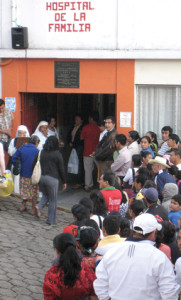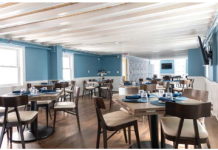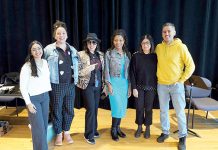
Photo courtesy Dr. Ronald Kristan.
Area ophthalmologists, staff take part in medical missions to treat eye issues
By Judy O’Gorman Alvarez
LONG BRANCH – The doctors of Atlantic Eye Physicians heal a lot of eye ailments in their Monmouth County practice but last month three surgeons and two technicians spent a week treating eye issues of people who do not have access to such care.
Drs. Ronald Kristan, Peter Bontempo and Robert Fegan, along with ophthalmic technician Patricia Rowan and surgical scrub technician Jodi Swire, traveled to Hospital de la Familia in Nuevo Progreso, in the state of San Marcos in southwestern Guatemala to treat the literally hundreds of patients who lined up each day.
It was Kristan’s third trip to the remote hospital, each time with another group of volunteers from his practice.
Kristan, whose practice also has offices in Holmdel and Little Silver, first got involved in the Hospital de la Familia Foundation through a friend who has been organizing medical missions there for some time.
“It’s a learning experience,” he said, “trying to understand the culture, and trying to deal with unusual eye pathology… We learned you have to resort to different techniques.
“There’s no sense of what is appropriate care because there is none in these types of places,” he said.
The doctors treat and try to cure as many eye ailments as they can.
The main concern when going on a medical mission, according to Kristan, is the medication, medical instruments and equipment that may be needed. Returning to the same hospital, which has been sparsely outfitted with donations over the years, allows the doctors to know what to bring.
“We brought ancillary supplies and various types of intraocular medication that helps us do these more difficult cases,” he said. “We have learned over the years what we need.”
Volunteer surgical teams visit the hospital four times a year. During the February trip, Dr. Lester Molbegott from Monmouth Beach, led a team of 47 medical professionals, including the five from Atlantic Eye Physicians. Among the team members were general surgeons, plastic surgeons, nurses, nurse anesthetics, technicians and others.
After a flight to Guatemala City, the team took a five-hour bus ride to the hospital, located in the mountains. They stayed at the hospital’s bare bones quarters across the street. Hospital staff cooked all their meals and it goes almost without saying – that they didn’t drink the water.
The arrival of the medical team is always welcome news for residents awaiting care so people came from miles around and lined up early in the morning for medical treatment.

Photo courtesy Dr. Ronald Kristan.
The medical mission offers tiring but rewarding days of work. “You work as hard as you can for as long as you can, recognizing you can’t burn yourself out too quickly,” Kristan said.
During past years, the team performed surgeries in a main operating room, alongside physicians performing various surgeries such as repairing cleft palates, removing gallbladders and repairing hernias.
“There are six operations going on at the same time,” Kristan said. “There is lots of drilling, lots of noise.”
Now, however, an operating room is dedicated for eye surgery, allowing three eye operations to go on at the same time. “Because the eye service is so busy, they’ve separated it from the hospital to form its own area,” Kristan said.
The eye team spent a week working full days, performing procedures such as cataract removal and treating chronic eye disease.
“The main one was glaucoma,” Kristan said. “There were a lot of blind eyes.” A higher incidence of pseudoexfoliation is a genetic trait found in people in the area.
Accompanying the eye team was a pediatric ophthalmologist who was able to treat children, including many who suffered from crossed eyes.
For one child, a 1½-year-old boy who suffered from congenital cataracts, they were able to successfully remove both cataracts. Kristan said watching the boy see for the first time – carefully inspecting his own hands and then gazing at his mother’s face – was especially memorable.
“And there was a young man (age 16) that I operated on who had a trauma to an eye when he was 2 and had multiple surgeries,” Kristan said. “His eye had become nonfunctioning; it was shriveled up,” disfiguring him. “He had traveled with his mother eight hours by bus and walked an hour to see if we could do anything.”
Using a glass eye that the doctors brought with them, Kristan, who also specializes in eye plastic surgery, performed an aesthetic procedure to correct the deformity.
“We made him look so much better,” he said. The mother gave Kristan a token from her Bible as thanks. “She told me to always keep it close,” he said. “It was very emotional.”
The volunteers fly at their own expense and with three physicians from the same practice, plus staff, extreme scheduling and organizing is called for. “It’s a sacrifice, but, once you do it, you’re hooked,” Kristan said. “The amazing thing is there’s a waiting list to come on this trip.
“It’s a very emotional trip because we help a lot of people and these people would not be able to see without us being there,” he said.
For more information about Hospital de la Familia Foundation, visit http://www.hospitaldelafamilia.com.














